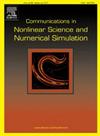Optimal control for a reaction–diffusion model with tumor-immune interactions
IF 3.8
2区 数学
Q1 MATHEMATICS, APPLIED
Communications in Nonlinear Science and Numerical Simulation
Pub Date : 2025-02-18
DOI:10.1016/j.cnsns.2025.108677
引用次数: 0
Abstract
The main objective of this paper is to consider an optimal distributed control problem for a reaction–diffusion model with tumor-immune interactions, which consists of a coupled system of reaction–diffusion equations for normal cells, tumor cells, immune cells and chemotherapeutic drug. Moreover, a suitable distributed control variable representing the concentration of cytotoxic drugs in medical treatment is introduced into the equation of chemotherapeutic drug. We first establish the well-posedness of the state system by combining of truncation method, Faedo–Galerkin method and maximum principle of second-order parabolic equations. Then we prove the existence of an optimal control, the Fréchet differentiability of the control-to-state operator in a suitable functional analytic framework, and finally deduce the corresponding first-order necessary conditions of optimality by studying the corresponding linearized system and the backward adjoint system.
肿瘤-免疫相互作用反应-扩散模型的最优控制
本文的主要目的是考虑具有肿瘤-免疫相互作用的反应-扩散模型的最优分布控制问题,该模型由正常细胞、肿瘤细胞、免疫细胞和化疗药物的反应-扩散方程耦合系统组成。此外,在化疗药物方程中引入了一个合适的分布控制变量,表示医学治疗中细胞毒性药物的浓度。首先结合截断法、费奥多-伽辽金法和二阶抛物方程的极大值原理建立了状态系统的适定性。然后在合适的泛函解析框架下证明了最优控制的存在性,即控制-状态算子的fr可微性,最后通过研究相应的线性化系统和后向伴随系统,推导出相应的一阶最优性必要条件。
本文章由计算机程序翻译,如有差异,请以英文原文为准。
求助全文
约1分钟内获得全文
求助全文
来源期刊

Communications in Nonlinear Science and Numerical Simulation
MATHEMATICS, APPLIED-MATHEMATICS, INTERDISCIPLINARY APPLICATIONS
CiteScore
6.80
自引率
7.70%
发文量
378
审稿时长
78 days
期刊介绍:
The journal publishes original research findings on experimental observation, mathematical modeling, theoretical analysis and numerical simulation, for more accurate description, better prediction or novel application, of nonlinear phenomena in science and engineering. It offers a venue for researchers to make rapid exchange of ideas and techniques in nonlinear science and complexity.
The submission of manuscripts with cross-disciplinary approaches in nonlinear science and complexity is particularly encouraged.
Topics of interest:
Nonlinear differential or delay equations, Lie group analysis and asymptotic methods, Discontinuous systems, Fractals, Fractional calculus and dynamics, Nonlinear effects in quantum mechanics, Nonlinear stochastic processes, Experimental nonlinear science, Time-series and signal analysis, Computational methods and simulations in nonlinear science and engineering, Control of dynamical systems, Synchronization, Lyapunov analysis, High-dimensional chaos and turbulence, Chaos in Hamiltonian systems, Integrable systems and solitons, Collective behavior in many-body systems, Biological physics and networks, Nonlinear mechanical systems, Complex systems and complexity.
No length limitation for contributions is set, but only concisely written manuscripts are published. Brief papers are published on the basis of Rapid Communications. Discussions of previously published papers are welcome.
 求助内容:
求助内容: 应助结果提醒方式:
应助结果提醒方式:


